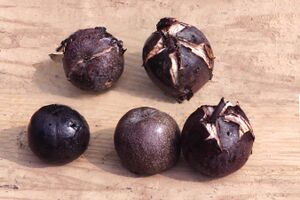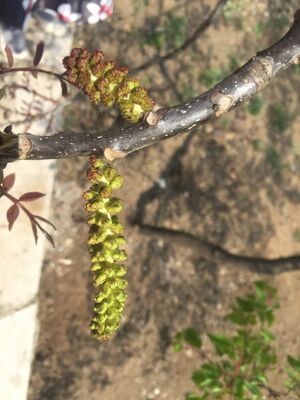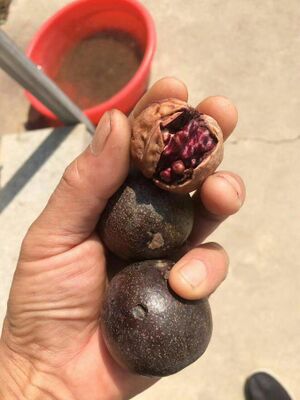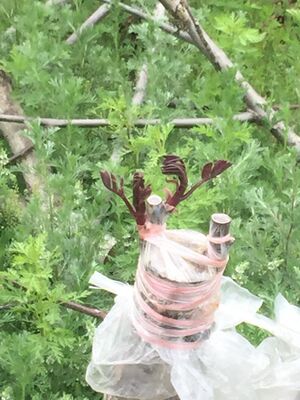Biology:Juglans regia 'Zijing'
| Juglans regia 'Zijing' | |
|---|---|
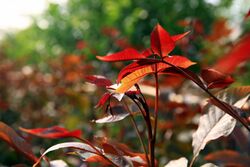 | |
| Genus | Juglans |
| Species | Juglans regia |
| Cultivar | 'Zijing' |
Juglans regia 'Zijing' (Chinese: 紫京彩叶核桃树,紫京核桃树) is a cultivar of walnut developed in Beijing, China.[1] IT was developed frommother trees of purple-leaved walnut, which was found in the mountains of Qingshui, Mentougou District, China in 1998.[2]
J. regia Zijing was cultivated by Wang Xiupo.[1][3] On 17 October 2017, Wang obtained the certificate of plant variety rights from the State Forestry Administration of China.[4] Because J. regia Zijing trees have five major purple features: female flowers, leaves, peel, and kernels, they are also called Wuzi Walnut (五紫核桃).[5] The trees are mainly distributed in Beijing International Walnut Manor.[1]
Applications
- Landscape agriculture
- Military and furniture items
- Road greening protection
Habitat
They grow at an altitude of about 800 meters, J. regia Zijing trees have strong resistance and adaptability, and are adapted to temperate climate regions.
Flowering takes place in May in the Northern Hemisphere, fruiting in September.[1][6]
Because walnuts are light-preferring plants, it is better to use south-facing slopes in the Northern Hemisphere.[1]
Cultivation
Planting time is around germination in late March. The survival rate of one to two year old seedlings is higher. After planting, it should be irrigated with water and fertilised.
Weeding should be performed frequently, and drainage is important during rainy seasons. They further require protection from pests and diseases from June to July.[6]
Scion collection
Pest-free developing branches and annual branches are collected in mid-March to serve as scions.[1]
Grafting time
Grafting is appropriate from the end of May to the beginning of July.[6]
Bacterial root rot
Bacterial nuclear root rot, caused by Sclerotinia sclerotiorum, causing seedling root and lateral root cortex decay, resulting in the death of J. regia Zijing. Prevention and treatment involve selecting nursery lands, managing soil water content, disinfecting seeds and soil guality.[6]
References
- ↑ 1.0 1.1 1.2 1.3 1.4 1.5 "紫京彩叶核桃树大起底". Eastnet (zh). http://caijing.chinadaily.com.cn/chanye/2018-03/01/content_35764467.htm.
- ↑ "中华人民共和国国家林业局植物新品种保护办公室林业植物新品种保护公告". http://www.cnpvp.gov.cn/upfiles/201609130941331.PDF.
- ↑ "紫色核桃树,绿化怎么用?" (in en). China Flower News. https://www.sohu.com/a/244569100_740038.
- ↑ "北京国际核桃庄园成功研发紫京彩叶核桃树-千龙网·中国首都网". China Internet Information Center. http://finance.qianlong.com/2018/0329/2490764.shtml.
- ↑ "紫京核桃十分稀有 年产量只有十几个". Beijing Television. 2017-09-30. https://item.btime.com/86h42oilm1ddfvjjfqkmupvrsrq.
- ↑ 6.0 6.1 6.2 6.3 "紫京彩叶核桃树 惊艳世界 特立独行". Phoenix Television. http://news.ifeng.com/a/20180301/56392593_0.shtml.
 |
